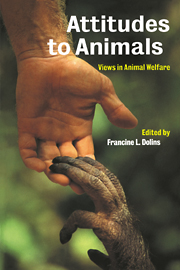Book contents
- Frontmatter
- Contents
- List of contributors
- Acknowledgements
- Part I Attitudes to animals
- Part II Animal awareness
- Part III Animal welfare
- Part IV Research and education
- 12 Humane education: the role of animal-based learning
- 13 ‘Minding animals’: the role of animals in children's mental development
- 14 Alternatives to using animals in education
- 15 Animals in scientific education and a reverence for life
- Part V Epilogue: the future of wild animals
- Index
15 - Animals in scientific education and a reverence for life
Published online by Cambridge University Press: 16 November 2009
- Frontmatter
- Contents
- List of contributors
- Acknowledgements
- Part I Attitudes to animals
- Part II Animal awareness
- Part III Animal welfare
- Part IV Research and education
- 12 Humane education: the role of animal-based learning
- 13 ‘Minding animals’: the role of animals in children's mental development
- 14 Alternatives to using animals in education
- 15 Animals in scientific education and a reverence for life
- Part V Epilogue: the future of wild animals
- Index
Summary
A contradiction in the goals of biology education
In many countries one of the goals of biology education is to promote respect for all forms of life. Bowd (1993, p. 84) refers to the National Science Teachers Association (1980) in North America, stating that the central affective goal in the secondary science education curriculumis that learning should engender a ‘reverence for life’. He brings up the question of whether killing and dissecting animals for educational purposes is not contradictory to this aim. This chapter will present the inbuilt tension between this goal of biological education and the emphasis within modern biology on the objectification of nature, including the experimental reductionistic methods of studying living nature. Commenting on Bowd, Lock (1994, p. 76) writes that ‘It is much more common now for animals to be dissected and used for an investigation directed towards an understanding of the process of scientific enquiry’, rather than as an exploration in anatomy. Here lies the heart of the problem: to understand the role of dissection and animal experimentation in biology, we have to understand the process of scientific enquiry.
When teaching students about the methodological, social and ethical aspects of biology, it is important to develop a conceptual framework which is effective in sensitizing students to the philosophical aspects of biology. In the framework used by the author various biological disciplines are looked at as operating between two imaginary poles, the poles of ‘given nature’ and of ‘constructed nature’. ‘Given nature’ refers to nature which exists autonomously, independent of human influences (‘wild’ nature).
- Type
- Chapter
- Information
- Attitudes to AnimalsViews in Animal Welfare, pp. 218 - 228Publisher: Cambridge University PressPrint publication year: 1999
- 1
- Cited by



